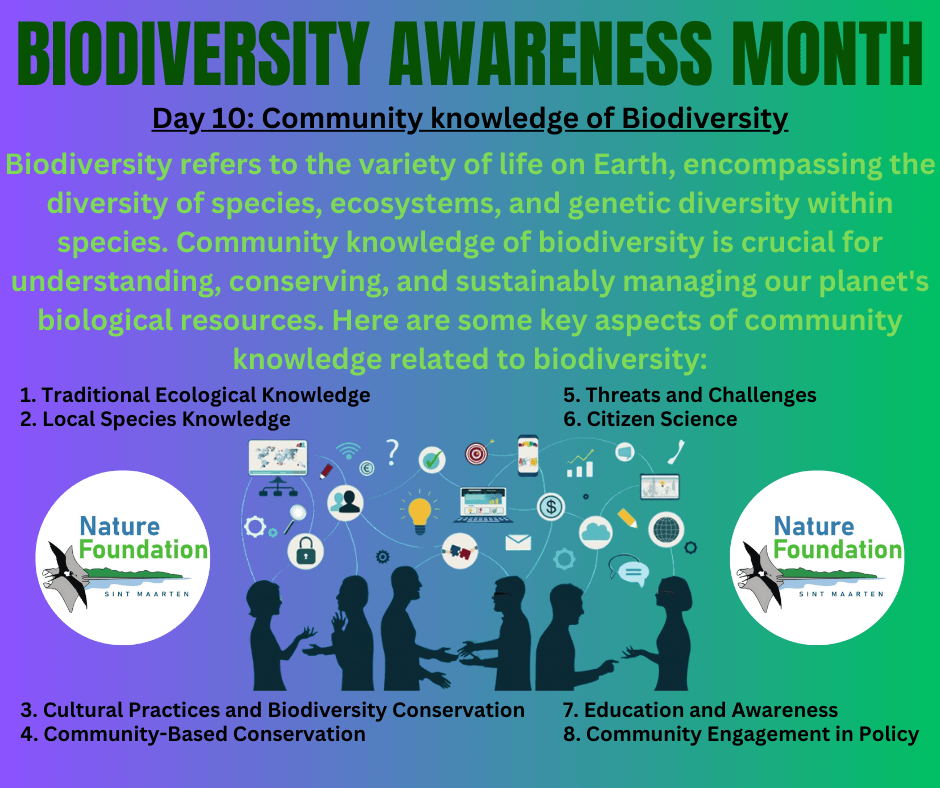Biodiversity month day 10: community knowledge of biodiversity
Biodiversity refers to the variety of life on Earth, encompassing the diversity of species, ecosystems, and genetic diversity within species.
The St. Maarten Hospitality & Trade Association supports the March Biodiversity awareness month organized by the Nature Foundation in an effort to help protect St. Maartens nature and biodiversity. Todays topic: Community Knowledge of Biodiversity
Community knowledge of biodiversity is crucial for understanding, conserving, and sustainably managing our planet’s biological resources. Here are some key aspects of community knowledge related to biodiversity:
1. Traditional Ecological Knowledge (TEK): Indigenous and local communities often possess valuable traditional ecological knowledge that has been passed down through generations. This knowledge includes insights into local ecosystems, plant and animal behavior, and sustainable resource management practices.
2. Local Species Knowledge: Communities living in specific regions often have a deep understanding of the flora and fauna native to their area. This knowledge is critical for identifying and conserving local species, as well as understanding their ecological roles.
3. Cultural Practices and Biodiversity Conservation: Many communities have cultural practices that inherently contribute to biodiversity conservation. These may include taboos or rituals that protect certain species or ecosystems, promoting a harmonious relationship between people and nature.
4. Community-Based Conservation: In various parts of the world, communities actively engage in conservation efforts. This involves the development and implementation of community-led initiatives to protect natural habitats, restore ecosystems, and manage resources sustainably.
5. Threats and Challenges: Local communities often have firsthand knowledge of the threats and challenges facing biodiversity in their areas. This may include habitat loss, pollution, climate change impacts, and unsustainable exploitation of natural resources. Understanding these threats is crucial for developing effective conservation strategies.
6. Citizen Science: Individuals within communities can contribute to biodiversity research through citizen science initiatives. This involves non-professional scientists collecting data on local flora and fauna, contributing valuable information to scientific databases, and helping monitor changes in biodiversity over time.
7. Education and Awareness: Community knowledge of biodiversity is often disseminated through education and awareness programs. Teaching community members about the importance of biodiversity, its role in ecosystem services, and the impacts of human activities can empower them to make informed decisions and participate in conservation efforts.
8. Community Engagement in Policy and Decision-Making: Inclusive decision-making processes that involve local communities are essential for effective biodiversity conservation. Communities can contribute valuable insights and perspectives that shape policies and practices related to land use, resource management, and conservation.
In summary, community knowledge of biodiversity is diverse and multifaceted, encompassing traditional ecological knowledge, local species expertise, cultural practices, and active participation in conservation efforts. Recognizing and integrating this knowledge into broader conservation initiatives is crucial for the sustainable management of Earth’s biodiversity.
Back to the Visit St Maarten Main page

